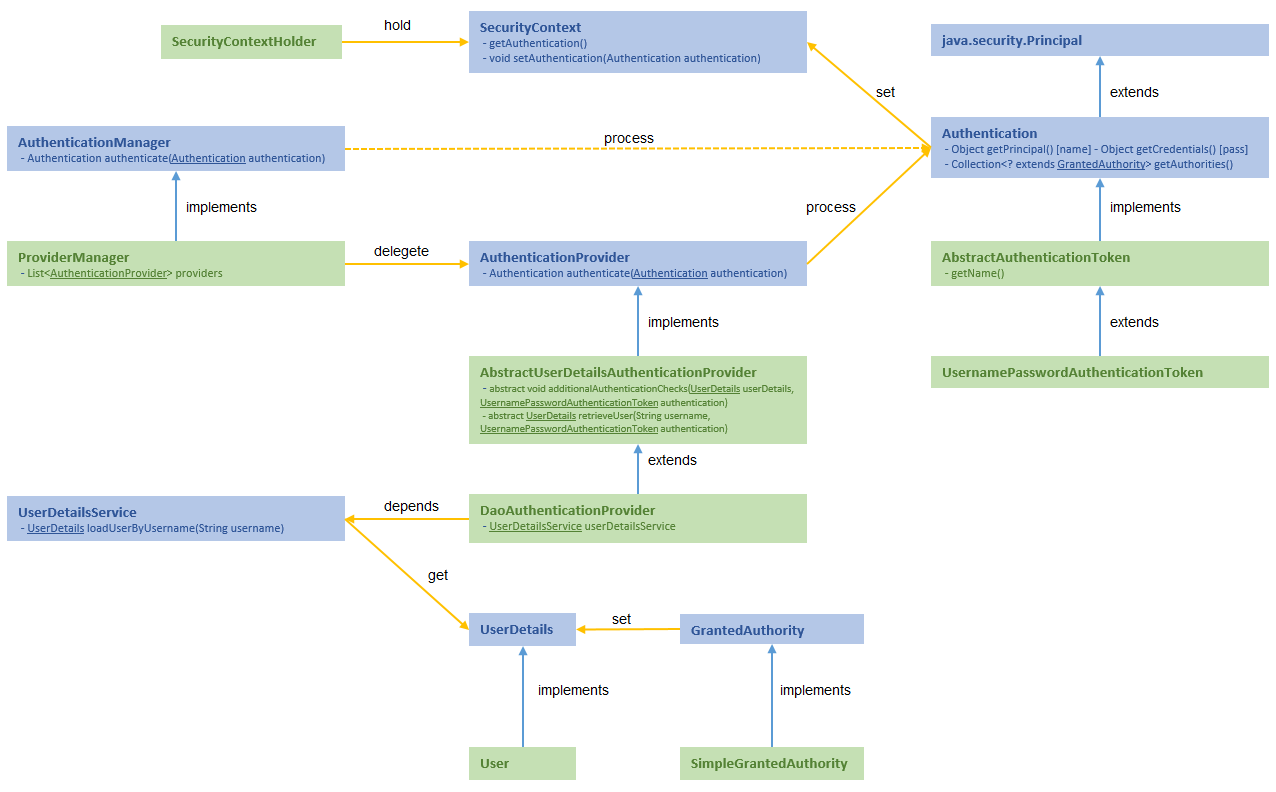Spring Security(1):认证和授权的核心组件介绍及源码分析
Spring Security是一个能够为基于Spring的企业应用系统提供声明式的安全访问控制解决方式的安全框架。它包括认证(Authentication)和授权(Authorization)两个部分。
用户认证指的是验证某个用户是否为系统中的合法主体,也就是说用户能否访问该系统。用户认证一般要求用户提供用户名和密码。系统通过校验用户名和密码来完成认证过程。用户授权指的是验证某个用户是否有权限执行某个操作。
一般来说,系统会为不同的用户分配不同的角色,而每个角色则对应一系列的权限。 spring security的主要核心功能为认证和授权,所有的架构也是基于这两个核心功能去实现的。
认证的核心组件:

[AuthenticationManager] 是一个接口,是认证方法的入口,定义了如何认证,接收一个Authentication对象作为参数。
[ProviderManager] 是AuthenticationManager的一个默认实现,但它并不用来处理身份认证,而是委托给配置好的AuthenticationProvider。在ProviderManager的authenticate方法中,会轮训成员变量List<AuthenticationProvider> providers。该providers中如果有一个AuthenticationProvider的supports函数返回true,那么就会调用该AuthenticationProvider的authenticate函数认证,如果认证成功则整个认证过程结束。如果不成功,则继续使用下一个合适的AuthenticationProvider进行认证,只要有一个认证成功则为认证成功。
[AuthenticationProvider] 是一个接口,ProviderManager实际上把认证过程委托给了AuthenticationProvider对象(实际上是一个List)来处理。AuthenticationProvider的实现类有很多,如:
DaoAuthenticationProvider (extends AbstractUserDetailsAuthenticationProvider):最常用的认证方式,通过UserDetailsService对UserDetails认证。
AnonymousAuthenticationProvider: 用于匿名身份认证,匿名用户名和权限使用默认值为anonymousUser,ROLE_ANONYMOUS

[Authentication] 是一个接口,它定义存储用户的Principal(用户信息),Credentials(密码),Authority(权限)等信息。它将提供这些信息给AuthenticationManager(AuthenticationProvider的各种实现类)进行验证。验证成功后,返回一个认证成功的Authentication的实现类的对象。Authentication的实现类也有很多,并且和AuthenticationProvider对应, 如:
DaoAuthenticationProvider -> UsernamePasswordAuthenticationToken
AnonymousAuthenticationProvider -> AnonymousAuthenticationToken

[UserDetails] 是一个接口,定义了认证所需的必要信息,包括用户名,密码,权限,有效性等。在实际使用里,(比用JPA)通过定义User实体类与DB中的User表和Role表映射实现UserDetails接口。也可以使用框架的User实现类来构造User,比如使用AuthenticationManagerBuilder中的inMemoryAuthentication()方法或jdbcAuthentication()方法获取InMemoryUserDetailsManagerConfigurer或JdbcUserDetailsManagerConfigurer对象来构造。
[SecurityContextHolder] & [SecurityContext] SecurityContextHolder是SecurityContext的存放容器,默认使用ThreadLocal存储,意味SecurityContext在相同线程中的方法都可用。由于SecurityContext中存放有Authentication信息,因此我们可以通过用这种方式在Security上下文中拿到User信息。如:
Object principal = SecurityContextHolder.getContext().getAuthentication().getPrincipal(); if (principal instanceof UserDetails) { String username = ((UserDetails)principal).getUsername(); } else { String username = principal.toString(); }
以上就是各个接口的意义及关系,认证中其实最重要的就是authenticate()方法的实现。上面也说到,AuthenticationManager把该方法委托给AuthenticationProvider来做,接下来就以AuthenticationProvider的一个最常用的实现类DaoAuthenticationProvider来叙述以下认证过程(具体代码可以从AbstractUserDetailsAuthenticationProvider.authenticate()开始看):
(1)从request中拿到username和password,存到一个UsernamePasswordAuthenticationToken(Authentication的接口实现类)对象中
(2)开始调用AbstractUserDetailsAuthenticationProvider.authenticate()方法
(3)拿到UsernamePasswordAuthenticationToken的username
(4)调用DaoAuthenticationProvider.retrieveUser(),用步骤3的username,调用UserDetailsService.loadUserByUsername()方法拿到User对象(UserDetails的接口实现类)
(5)检查步骤4中User对象的有效性(enabled,expired,locked)
(6)调用DaoAuthenticationProvider.additionalAuthenticationChecks(),比较UsernamePasswordAuthenticationToken的password和UserDetails的password(都是encoded),一致则通过
(7)调用AbstractUserDetailsAuthenticationProvider.createSuccessAuthentication()修改和完善UsernamePasswordAuthenticationToken信息,比如从UserDetails拿到的Authorities信息
(8)返回UsernamePasswordAuthenticationToken
授权的核心组件:

[AccessDecisionManager] 是一个接口,定义了在授权时如何决策的方法,具体的实现类有3个:AffirmativeBased (一票通过) ,ConsensusBased (少数服从多数),UnanimousBased (一票反对)。其中,一票通过是默认的决策。
[AbstractAccessDecisionManager] 从这个抽象类可以看出,决策的依据是是选票(Voter)的List集合。
[AccessDecisionVoter] 是一个接口,定义了vote方法,它的实现类也有很多,比如:
AuthenticatedVoter:比如某个用户对某个资源的访问是isAuthenticated()(即认证用户),该投票就通过
RoleVoter:比如某个用户对某个资源的访问是hasAnyRole("xxx")或hasRole("xxx")(即有该Role的用户),该投票就通过

我们以AffirmativeBased为例子看一下授权过程:
(1)调用AffirmativeBased.decide()方法
(2)轮训成员变量List<AccessDecisionVoter<? extends Object>> decisionVoters(在父级方法AbstractAccessDecisionManager中),如果有voter中有一个是ACCESS_GRANTED(1),则授权通过。




